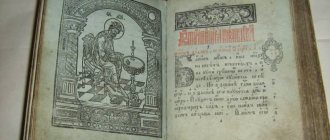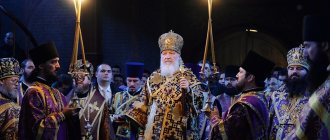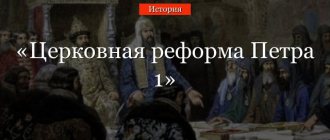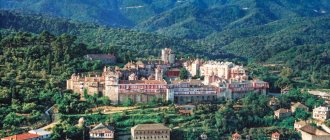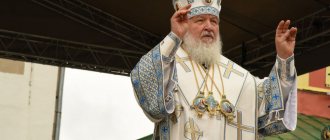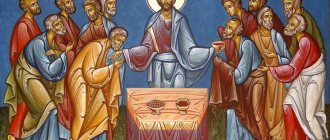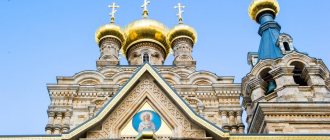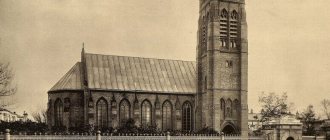Meeting, entrance prayers and vestments of the bishop
After vesting, the bishop stands in front of the front of the throne, and the deacons are on the right and left sides of him, opposite the front corners of the throne.
The serving priest , after vesting, completes the sequence of figurative acts on the sole , and then returns to the altar by the southern door and takes his place of standing before the altar.
During the officiating priest's pronouncement of dismissal
the first pair
of subdeacons with dikiriy and trikyriy go to the high place. Here they cross themselves three times, bow to the bishop, to each other, and exit the altar through the north and south doors. On the solea they stand to the right and left of the royal doors, facing each other: the senior subdeacon with the trikirium exits by the southern door and stands on the right in front of the icon of the Savior near the staff-bearer , and the second subdeacon with the dikirium exits by the northern door and stands on the left in front of the icon of the Mother of God. The candle-bearer with a candle stands at the bottom and in the middle, facing the altar.
After the completion of the fine arts the deacons open the royal doors, then all the clergy
they cross themselves twice, kiss the Holy Altar, cross themselves a third time and bow to
the bishop, who blesses them with a common overshadowing. The first pair of subdeacons with dikyriy and trikyriy descends from the solea and stands to the right and left of the priest , facing each other.
The bishop comes out through the open royal doors onto the soleya, accepts the staff from the staff bearer , goes to the pulpit and blesses the people praying in the temple. All subdeacons turn to the east and bow in response to his blessing (except for the staff bearer, who also bows, but at the same time walks to the right of the bishop behind him). The candlebearer with the candle moves away and stands to the left of the lectern.
The bishop descends from the pulpit and walks along the carpet path to the middle of the church and stands on the eagle prepared for him on the bishop's pulpit. In front of him is the first pair of subdeacons with a dikiri and trikiri and a candle-bearer with a candle, and behind him is a staff-bearer.
The deacons close the royal doors, and all the clergy
following
the bishop, they leave the altar through the northern and southern doors onto the sole and also go to the bishop's pulpit behind the bishop : the priests walk in pairs (the elders are in front), and behind them are the deacons (the elders are in front). The first pair of priests supports the bishop as he ascends to the bishop's pulpit. The priests stand to the right and left of the bishop according to rank (the senior priests are closer to the bishop), and the deacons (the seniors are in front). The first pair of subdeacons with a dikiri and trikiri stand the junior priests in front of the lectern with a festive icon: the senior sub-deacon with a trikiri on the right, and the second with a dikiri on the left. The candlebearer with a candle stands in front of the lectern with a festive icon in the middle, facing west.
When everyone is in place, the priests, deacons and subdeacons , at the sign of the protodeacon , cross themselves to the east, bow to the bishop, who blesses them with a common overshadowing, and turn to face each other.
The bishop gives the staff to the staff-bearer. The staff-bearer accepts the staff, and they stand on the right in front of the lectern with the festive icon next to the candle-bearer, facing west. The first pair of subdeacons rise to the bishop's pulpit, present the bishop , straighten their sleeves on the sakkos and then stand in front of the bishop in a row on the sides of the staff-bearer and the priest-bearer.
The second deacon says: “Let us pray to the Lord,” and the protodeacon exclaims: “So let your light shine before men, so that they may see your good deeds and glorify our Father who is in heaven, always, now and ever, and to the ages of ages, amen.” .
The choir sings: “Ton despotin ke archierea imon, Kyrie, filate (once), is polla eti, despota” (three times).
The bishop, while singing: “Ton despotin...” overshadows the people in four directions, and then gives the dikiri and trikiri to the subdeacons.
The first pair
of subdeacons bow once, then approach the bishop, accept the dikirius and trikirii from him, and again stand in line with the staff-bearer and the priest-bearer.
Next, all the subdeacons together bow three times to the bishop, who blesses them all. Then all the priests, deacons and subdeacons cross themselves to the east and again bow to the bishop.
After this, the deacons stand one after another between the priests in front of the bishop's pulpit (the older ones are closer to the bishop's pulpit).
At the same time, the staff-bearer and the candle-bearer take their places on the solea, and the first pair of subdeacons go to the altar. In the altar, the subdeacons go to the high place, where they cross themselves, bow to each other and stand in front of the throne near the royal doors: the senior subdeacon on its southern side, and the second subdeacon on the northern side.
⇐ Previous20Next ⇒
Recommended pages:
Instructions for bishop's service
During the divine service, which is performed by the bishop, objects that belong only to the bishop's service are used: special candlesticks - dikiri and trikiri, ripids, orlets, a rod (staff).
Dikirium and trikirium are two hand-held shaped lamps with cells for two and three long candles. Dikiriy with burning candles signifies the light of the Lord Jesus Christ, cognizable in two natures. Trikirium means the uncreated light of the Holy Trinity. Dikiriy has the sign of the cross in the center between two candles. In ancient times, it was not customary to put a cross on the trikiria, since the feat of the cross was accomplished only by the incarnate Son of God.
Candles burning in dikirias and trikirias are called double-braided, triple-braided, autumnal, or autumnal. In the cases provided for by the Charter, dikirii and trikirii are worn before the bishop, who blesses the people with them. The right to bless with these lamps is sometimes granted to the archimandrites of some monasteries.
At the liturgy, after vesting and entering the altar, while singing “Come, let us worship,” the bishop overshadows the people with a dikiriy, which he holds in his left hand, and a trikiriy in his right. After the small entrance, the bishop censes, holding the dikiri in his left hand. When singing the Trisagion, he overshadows the Gospel on the throne with a dikiriy, having it in his right hand, and then, holding a cross in his left hand, and a dikiriy in his right, blesses the people with them. These actions show that the Trinity unity was especially revealed to people through the coming in the flesh of the Son of God, and finally, that everything done by the bishop in the church happens in the name of the Lord and according to His will. The overshadowing of people with light, signifying the Light of Christ and the Holy Trinity, imparts special grace to believers and testifies to them of the Divine light coming to people for their enlightenment, purification and sanctification. At the same time, the dikiriy and trikiriy in the hands of the bishop mean the fullness of God’s grace, which pours out through him. Among the ancient fathers, the bishop was called the enlightener, or enlightener, and imitator of the Father of Lights and the True Light - Jesus, having the grace of the apostles, who were called the light of the world. The bishop leads to the light, imitating Christ - the light of the world.
Dikiria and trikiria were introduced into church use probably no earlier than the 4th–5th centuries.
Ripides (Greek – fan, fan) have been used during the celebration of the sacrament of the Eucharist since ancient times. The liturgical instructions of the Apostolic Constitutions say that two deacons should hold ripids made of thin skins, or peacock feathers, or thin linen on both sides of the altar and quietly drive away flying insects. Ripides, therefore, began to be used mainly for practical reasons.
By the time of Sophronius, Patriarch of Jerusalem (1641), in the church consciousness the ripids were already images of cherubim and seraphim, invisibly participating in the sacraments of the Church. Probably from that same time, images of angelic beings, most often seraphim, began to appear on the ripids. Patriarch Photius of Constantinople (IX century) speaks of rhipids made of feathers in the image of six-winged seraphim, which, in his opinion, are called upon to “not allow the unenlightened to dwell with their minds on the visible, but to distract their attention so that they turn the eyes of their minds to the highest and ascend from visible to invisible and to indescribable beauty." The shapes of ripids are round, square, and star-shaped. In the Russian Orthodox Church, since the adoption of Christianity, ripids were made of metal, with the image of seraphim.
The final appearance that the ripida acquired was a radiant circle of gold, silver, and gilded bronze with the image of a six-winged seraph. The circle is mounted on a long shaft. This view fully reveals the symbolic meaning of this item. Ripides mark the penetration of angelic forces into the mystery of salvation, into the sacrament of the Eucharist, and the participation of heavenly ranks in worship. Just as deacons drive away insects from the Holy Gifts and create a breath of kind of wings over the Gifts, so the Heavenly Forces drive away the spirits of darkness from the place where the greatest of the sacraments is performed, surround and overshadow it with their presence. It is appropriate to remember that in the Old Testament Church, by the command of God, images of two cherubim made of gold were built in the Tabernacle of Testimony above the Ark of the Covenant, and in other places there are many images of the same angelic ranks.
Since the deacon portrays himself as an angel serving God, upon ordination to the deacon, the newly ordained one is given a ripid into the hands, with which, upon receiving the rank, he begins to slowly signify the Holy Gifts with cruciform movements at the exclamation: “Singing, crying...”
Ripids are used to cover the paten and chalice at the great entrance during the liturgy; they are carried out in the statutory places of the bishop's service, in processions of the Cross, with the participation of the bishop, and on other important occasions. Ripids overshadow the coffin of the deceased bishop. The radiant gilded circle of the rhipida with the image of the seraphim represents the light of the highest immaterial forces that serve in close proximity to God. Since the bishop portrays the Lord Jesus Christ during the divine service, ripids became a property of only the bishop's service. As an exception, the right to serve with ripids was granted to the archimandrites of some large monasteries.
Orlets are also used during bishop's services - round rugs with the image of a city and an eagle soaring above it.
Orlets lie under the feet of the bishop in the places where he stops while performing actions during the service. They were first used in the 13th century in Byzantium; then they represented something like an honorary award from the emperor to the patriarchs of Constantinople. The double-headed eagle, the state emblem of Byzantium, was often depicted on royal chairs, carpets, even on the shoes of kings and the most noble dignitaries. Then they began to depict him on the shoes of the Patriarchs of Constantinople, Antioch and Alexandria. This image moved from shoes to the saints' carpets. In some temples, a mosaic circle with an image of an eagle was made on the floor in front of the altar since ancient times. After the capture of Constantinople by the Turks (1453), Rus' historically became the successor to the state and church traditions of Byzantium, so that the state emblem of the Byzantine emperors became the emblem of the Russian state, and eagles became the honorary symbol of Russian bishops. In the Russian rite for the installation of a bishop in 1456, the eagle is mentioned, on which the metropolitan should stand at his throne in the place of the vestments. In the same rite, it is commanded to draw “the eagle of the same head” on the platform specially built for episcopal consecration.
The eagle on Russian eagles was single-headed, in contrast to the double-headed ones on the eaglets of Byzantine saints, so the eagle in Rus' was not a royal reward, but an independent symbol of the Church.
In the XVI–XVII centuries. Orlets in Rus' necessarily lay down under the feet of the bishops when they entered the temple and when leaving it, standing on it, the bishops made the usual beginning of the service with a final bow. At the Moscow Council of 1675, it was determined that only the Metropolitans of Novgorod and Kazan could use orlets in the presence of the Patriarch. Then the Orlets became widely used in bishop's worship and began to rest at the feet of the bishops, where they had to stop for prayer, blessing the people and other actions. The spiritual meaning of the Orlets with the image of the city and the eagle soaring above it indicates, first of all, the highest heavenly origin and dignity of the episcopal rank. Standing on the eagle everywhere, the bishop seems to rest on the eagle all the time, that is, the eagle seems to constantly carry the bishop on itself. The eagle is a symbol of the highest heavenly creature of the angelic ranks.
The belonging of the serving bishop is the staff - a tall staff with symbolic images. Its prototype is an ordinary shepherd's crook in the form of a long stick with a rounded upper end, widespread since ancient times among eastern peoples. A long staff not only helps to drive sheep, but also makes it very easy to climb uphill. Moses walked with such a staff while tending the flocks of his father-in-law Jethro in the country of Midian. And the staff of Moses was destined for the first time to become an instrument of salvation and a sign of pastoral power over the verbal sheep of God - the ancient people of Israel. Having appeared to Moses in a burning and unburnt bush at Mount Horeb, the Burning Bush, the Lord was pleased to impart miraculous power to the staff of Moses (Ex. 4: 2–5). The same power was then given to Aaron’s staff (7, 8–10). With his rod, Moses divided the Red Sea so that Israel could walk along its bottom (Ex. 14:16). With the same staff, the Lord commanded Moses to draw water from a stone to quench the thirst of Israel in the desert (Ex. 17: 5–6). The transformative meaning of the staff (rod) is also revealed in other places of Holy Scripture. Through the mouth of the prophet Micah, the Lord speaks of Christ: “Feed Your people with Your rod, the sheep of Your inheritance” (Mic. 7:14). Shepherding invariably includes the concept of fair trial and spiritual punishment. Therefore, the Apostle Paul says: “What do you want? come to you with a rod or with love and a spirit of meekness?” (1 Cor. 4:21). The Gospel points to the staff as an accessory for pilgrimage, which, according to the Savior’s word, the apostles do not need, since they have support and support - the gracious power of the Lord Jesus Christ (Matthew 10:10).
Wandering, preaching, shepherding, as a symbol of wise leadership, is personified in the rod (staff). So the staff is the spiritual power given by Christ to His disciples, called to preach the word of God, teach people, knit and solve human sins. As a symbol of power, the rod is mentioned in the Apocalypse (2, 27). This meaning, which includes a variety of private meanings, is attributed by the Church to the bishop's staff - a sign of the archpastoral power of the bishop over the church people, similar to the power that a shepherd has over a flock of sheep. It is characteristic that the most ancient symbolic images of Christ in the form of the Good Shepherd usually represented Him with a staff. It can be assumed that the rods were in practical use by the apostles and were passed from them with a certain spiritual and symbolic meaning to the bishops - their successors. As an obligatory canonical accessory of bishops, the staff has been mentioned in the Western Church since the 5th century, in the Eastern Church - since the 6th century. At first, the shape of the bishop's staff was similar to a shepherd's crook with the upper part curved down. Then staves appeared with a two-horned upper crossbar, the ends of which were bent slightly downward, which resembled the shape of an anchor. According to the interpretation of Blessed Simeon, Archbishop of Thessaloniki, “the rod that the bishop holds means the power of the Spirit, the affirmation and shepherding of people, the power to guide, to punish those who disobey and to gather those who are far away to oneself. Therefore, the rod has handles (horns on top of the rod), like anchors. And over those hilts the Cross of Christ means victory.” Wooden, overlaid with silver and gold, or metal, usually silver-gilded, or bronze bishop's staffs with a double-horned handle in the form of an anchor with a cross at the top - this is the most ancient form of episcopal staffs, widely used in the Russian Church. In the 16th century in the Orthodox East, and in the 17th century. and in the Russian Church there appeared staves with handles in the form of two snakes, bending upward so that one turned its head towards the other, and the cross was placed between their heads. This was intended to express the idea of the profound wisdom of archpastoral leadership in accordance with the famous words of the Savior: “Be wise as serpents and simple as doves” (Matthew 10:16). Rods were also given to abbots and archimandrites as a sign of their authority over the monastic brethren.
In Byzantium, bishops were awarded with staffs from the hands of the emperor. And in Russia in the 16th–17th centuries. the patriarchs received their staffs from the kings, and the bishops from the patriarchs. Since 1725, the Holy Synod has made it the duty of the senior bishop by consecration to hand over the staff to the newly appointed bishop. It was customary to decorate bishop's staffs, especially metropolitan and patriarchal ones, with precious stones, drawings, and inlays. A special feature of Russian bishop's staffs is the sulok - two scarves inserted into one another and tied to the staff at the top crossbar - the handle. Sulok arose in connection with Russian frosts, during which religious processions had to be performed. The lower scarf was supposed to protect the hand from touching the cold metal of the rod, and the upper one was supposed to protect it from external cold. There is an opinion that reverence for the shrine of this symbolic object prompted the Russian hierarchs not to touch it with their bare hands, so that the sulok can also be considered a sign of God's grace covering the human weaknesses of the bishop in the great matter of governing the Church and in the use of God-given power over it.
Let your light shine before men
Our next conversation with the head of the biblical department of the Saratov Orthodox Theological Seminary, Alexei Kashkin, is devoted to the peculiarities of bishop's worship.
Bishop's services are loved by parishioners, they attract many people to the church, this expresses the love and traditional respect of the people for their ruler, and we also feel a certain special significance of the sacred rite performed by the archpastor. — Alexey Sergeevich, let’s start with the question: who is a bishop, in other words, a bishop?
We are accustomed to perceive him as a boss, a manager, a leader, if you like. But this is also how people external to the Church perceive it. Who is the bishop in the Church, since it is the Body of Christ? At the same time, please explain why, when we say “bishop,” we mean not only the bishop himself, but also the archbishop, the metropolitan, and the Patriarch? — From the first years of Christianity, the bishop (translated from Greek as “seeing from above” or “overseer”) in the community of believers is a symbolic representative of Jesus Christ Himself. After all, the first community was the apostles, who gathered directly around Him. And then the apostles fulfilled what He commanded - they ordained bishops (see: 1 Tim. 3 , 1-5), and the bishops became representatives of the Risen One for the believers they cared for. At first, only bishops celebrated the Eucharist; then, as the number of believers increased and new parishes were opened in large cities, bishops began to appoint assistants to themselves, and thus the priesthood arose. And today, without a bishop, there is no Church, and the priest performs the Sacrament only insofar as the bishop allows him to do so. And the Sacrament of the priesthood, that is, ordination, is performed only by the bishop.
The Church is inherently catholic, this term means “throughout the whole”: the Church is not limited by time, space, or earthly laws; when applied to each individual community, this means that the fullness of the gifts of grace is present in it, and Christ in this community performs the Sacrament through the hands of the bishop - His representative. This is reflected in the structure of the temple: the highest place in the altar is the symbolic throne of Jesus Christ, and only the bishop ascends to this place.
Bishop and bishop are essentially synonymous, but it is necessary to distinguish between two interrelated meanings of the word “bishop”: bishop in general (i.e., archbishop, metropolitan, and Patriarch) and a certain, junior level of the bishopric. Differences in title among bishops arose with the development of the Christian Church; they do not mean a difference in the gifts of grace, but only in administrative powers.
“So, we came to the temple for the bishop’s service. And the first thing we pay attention to is the elevation in the middle of the temple, on which the ruler will stand after entering the temple. What it is?
- Bishop's pulpit. Sometimes it is not quite correctly called the department. In the ancient Church, from this elevation the bishop or priest read the Gospel and delivered a sermon, and today the bishop's pulpit reminds us of the teaching role of the bishop.
— The bishop is always greeted solemnly in the church...
— In the Russian tradition there was even this: the bishop was met at his house and accompanied to the temple with singing. Now this is not the case, but when the bishop approaches the doors of the temple, he is greeted by the ringing of bells, and when he crosses the threshold, the rector of the temple brings out a cross to meet him on a special dish covered with air. The bishop kisses the cross, gives it to the clergy to kiss, then the priest returns the cross to the altar. Further, if it is Vespers, then the bishop rises to the pulpit, kisses the icons, blesses the people and enters the altar. If this is the Liturgy, then the bishop does not immediately enter the altar. The protodeacon reads the entrance prayers. They are the same as in a regular service, but if the presbyter reads them secretly before entering the altar, then in this case the protodeacon reads them with an exclamation. The bishop rises to the pulpit, the main prayer from the entrance is read on the pulpit: “Lord, send down Your hand...” - and then the Bishop, as always before the Liturgy, asks the clergy and people for forgiveness. The archdeacon replies: “May God forgive you, holy lord, forgive us and bless us.” Next, the bishop returns to the bishop's pulpit, and vestments begin.
- Why does the vestment of a bishop happen differently from the vestment of a priest - not in the altar, but in front of everyone?
- This does not always happen; the bishop has the right to vest himself at the altar. But the vestments in the middle of the church correspond to the solemnity of the bishop's service. In addition, the bishop’s entrance into the altar is the culmination of the service. Therefore, in most cases, the bishop vests himself before entering the altar. This was the case in ancient times. Only at the bishop's service can we directly see how the vestments of the clergy in general are performed.
— How do the vestments of a bishop differ from the vestments of a priest?
— Such items of the bishop’s vestment proper, such as the miter and panagia, are secondary; they appeared quite late in the history of the Church. The main and oldest difference is the omophorion. Without an omophorion, a bishop cannot perform divine services. The word "omophorion" translated from Greek means "carried on the shoulders." Symbolically, the omophorion means the very sheep that the shepherd lifts onto his shoulders (see: Luke 15 :5): the bishop is called to imitate Christ in caring for each sheep, for each individual soul. When placing the omophorion on the bishop, the protodeacon says: “On the frame, Christ, having taken the erring nature, you ascended, you brought God and the Father always, now and ever, and unto the ages of ages, Amen.” The remaining prayers for the vestment of the bishop coincide with the priestly ones. Only the first person is replaced by the second, because they are pronounced out loud by another person - not the one wearing the vestment. For example, instead of “Let my soul rejoice...” (the priest putting a vestment or saccos on the bishop) - “Let your soul rejoice in the Lord...”. Of course, prayers are added for those elements of the vestment that the priest does not have. Putting on a miter, for example - “The Lord put on your head a crown of precious stones...”. At the end of the vestment, the protodeacon solemnly proclaims: “Let your light shine before men, so that they may see your good deeds and glorify our Father who is in heaven, always, now and ever, and unto ages of ages, amen” (this is a paraphrase of Matt. 5 , 16).
— And when does the bishop enter the altar if he is celebrating the Liturgy?
— During the Liturgy, the bishop enters the altar only after the small entrance (entrance with the Gospel). Why is that? The part of the Liturgy preceding the small entrance appeared relatively late, and until about the 10th century it was perceived as something optional - it could have been omitted. For early Christians, the Liturgy began from the moment the clergy entered the altar with the Gospel. Therefore, now the bishop enters the altar at that moment, which is the ancient beginning of the Liturgy.
— So the bishop’s service takes us back to the first centuries of the Christian Church?
— One might say, in the 5th–7th centuries. Before the small entrance, the Liturgy proceeds in the usual manner: the bishop is on the bishop's pulpit and secretly reads the prayers of the antiphons. The entrance of the bishop into the altar is performed more solemnly than the entrance at the usual Liturgy; the entrance verse (“Come, let us worship and fall before Christ”) is sung several times. Immediately after the small entrance, the bishop censes. From the 5th to the 7th centuries, this is exactly how the service began: the bishop entered and performed incense. It was at this time that the choir sings “These Despots Executed” - translated as “For many years, lord.” An important detail: it is the rite of the bishop’s service that includes chants in Greek. (At an ordinary priestly service, singing in Greek is not necessary; this is the choice of the rector of the temple). Before the reading of the Apostle, the Trisagion is sung in Greek (“Agios o Theos, agios Ischiros...”). The Trisagion is sung not three times, as usual, but seven times; after the first three, the bishop comes out to the pulpit and says the words: “Look down from heaven, O God, and see, and visit this vineyard, and establish it, and plant it with your right hand” (see: Ps. 79 , 15-16), blessing the people cross and dikirie. The grapes are the people of God, in the psalm these words refer to Old Testament Israel, and for us - to the Church. Upon completion of the vestment of the bishop, “Ton despotin ke archhierea...” is sung - a prayer for the archpastor. Singing in Greek is explained by the fact that the Russian Church was a metropolitan for a long time, and until the middle of the 15th century it was ruled by Greek metropolitans.
— When the bishop enters the altar, the proskomedia has already been performed by the priests, the offering of the Honest Gifts is on the altar: what is the bishop’s proskomedia?
— This is a rather late Greek feature of the bishop’s Liturgy - the second proskomedia: the bishop takes out particles from the prosphora, commemorating the living and the dead. Only after this is the covering of the Holy Gifts performed on the altar. This happens during the Great Entrance.
— Why doesn’t the bishop come out with the clergy during the Great Entrance, why does he remain in the altar?
— This is also an echo of the ancient practice, according to which the Gifts were consecrated in a separate room (“offering”; in Greek it was called skevofylakion - “vessel-keeper”), and the deacons brought them from there to the altar, where the bishop was already located: he himself did not enter the skevofylakion . Therefore, even today the bishop accepts the gifts brought in at the altar, and does not bring them into it.
Before the reading of the Creed, the kiss of peace takes place in the altar: the bishop says to each suitable priest: “Christ is in our midst,” and the priest replies: “And there is and will be,” while kissing the shoulders and right hand of the bishop. Then a similar dialogue with kissing each other on the shoulders and hand occurs between the priests (such kissing happens at every Liturgy, it just looks more solemn at the Liturgy with the bishop's rite). The Eucharistic canon and communion of the clergy and laity in this case do not have any distinctive features. However, there is a practice - during the canon, the bishop reads secret prayers so that at least everyone in the altar can hear them.
Newspaper "Orthodox Faith" No. 8 (532)
